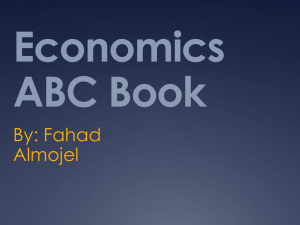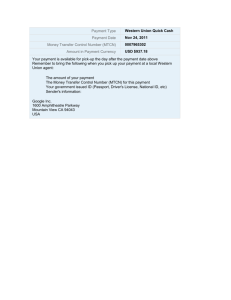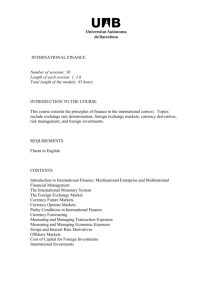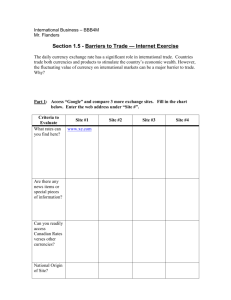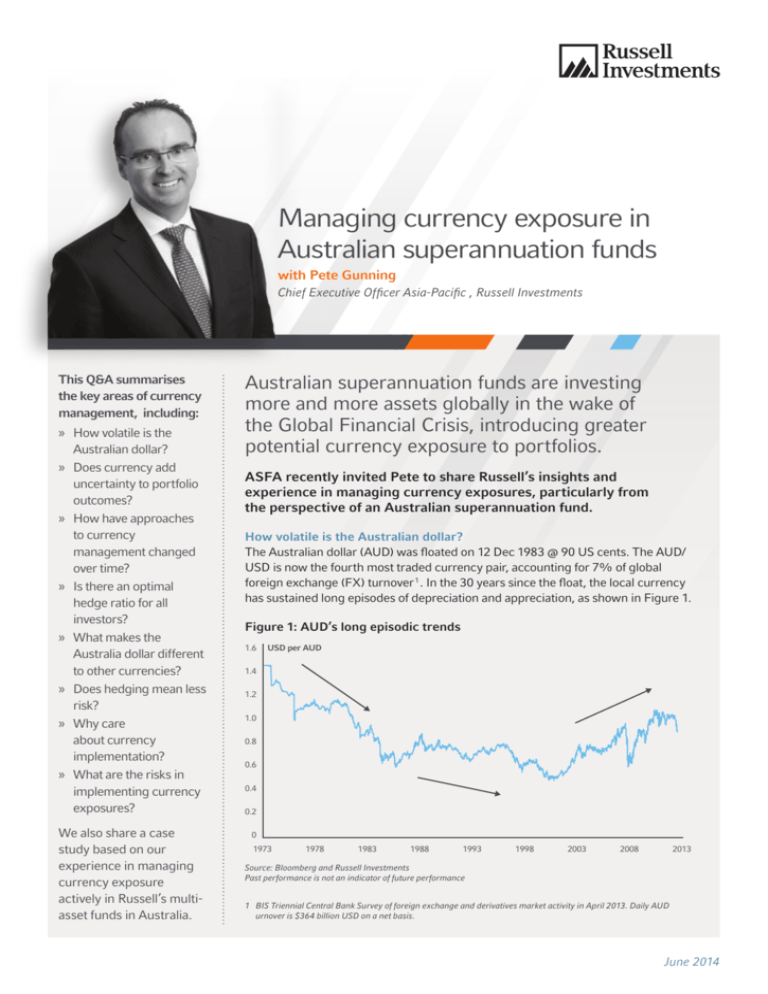
Managing currency exposure in
Australian superannuation funds
with Pete Gunning
Chief Executive Officer Asia-Pacific , Russell Investments
This Q&A summarises
the key areas of currency
management, including:
»» How volatile is the
Australian dollar?
»» Does currency add
uncertainty to portfolio
outcomes?
»» How have approaches
to currency
management changed
over time?
»» Is there an optimal
hedge ratio for all
investors?
»» What makes the
Australia dollar different
to other currencies?
»» Does hedging mean less
risk?
»» Why care
about currency
implementation?
»» What are the risks in
implementing currency
exposures?
We also share a case
study based on our
experience in managing
currency exposure
actively in Russell’s multiasset funds in Australia.
Australian superannuation funds are investing
more and more assets globally in the wake of
the Global Financial Crisis, introducing greater
potential currency exposure to portfolios.
ASFA recently invited Pete to share Russell’s insights and
experience in managing currency exposures, particularly from
the perspective of an Australian superannuation fund.
How volatile is the Australian dollar?
The Australian dollar (AUD) was floated on 12 Dec 1983 @ 90 US cents. The AUD/
USD is now the fourth most traded currency pair, accounting for 7% of global
foreign exchange (FX) turnover 1 . In the 30 years since the float, the local currency
has sustained long episodes of depreciation and appreciation, as shown in Figure 1.
Figure 1: AUD’s long episodic trends
1.6
USD per AUD
1.4
1.2
1.0
0.8
0.6
0.4
0.2
0
1973
1978
1983
1988
1993
1998
2003
2008
2013
Source: Bloomberg and Russell Investments
Past performance is not an indicator of future performance
1 BIS Triennial Central Bank Survey of foreign exchange and derivatives market activity in April 2013. Daily AUD
urnover is $364 billion USD on a net basis.
June 2014
Managing currency exposure in Australian superannuation funds
“Over this period,
the trading range
for the Australian
dollar has been
extremely wide”.
Figure 2: AUD vs Purchasing Power Parity
1.10
Rolling 10-year standard deviations
1.00
0.90
0.80
0.70
0.60
0.50
AUD/USD –
PPP estimate –
1 Std Dev Away --2 Std Dev Away – –
0.40
1986
1990
1994
1998
2002
2006
2010
2014
Source: Datastream, Russell Investments
Over this period, the trading range for the
Australian dollar has been extremely wide.
Based on Russell’s estimate of Purchasing
Power Parity (PPP) 2, the Australian dollar has
traded more than two standard deviations
away from PPP (or fair value), reaching as
low as 47.7 US cents in 2001 and as high
as USD110.8 in 2011, as shown in Figure 2.
The dollar has also experienced short term
volatility, plunging more than 15% in the
months after Paul Keating’s ‘Banana Republic’
comments 3 and falling more than 30% in mid
2008 during the Global Financial Crisis.
Figure 3: Five year rolling standard deviation of different currency pairs (annualised)
18
5 year rolling annualised currency volatility
16
14
12
2 Russell’s PPP estimate
provides a useful medium
to long-term reference point
about the likely direction of
currency going forward. It
is not designed as a short
term timing tool. The PPP
estimate is based on the
monetary theory of exchange
rates and measures how
much the AUD buys relative
to other currencies (in this
example, the USD, by taking
into account relative inflation
differentials).
3 “If this Government cannot
get the adjustment, get
manufacturing going again…
and a sensible economic
policy, then Australia is
basically done for. We
will end up being a third
rate economy... a banana
republic. “
Paul Keating on national
radio 14 May 1986
2
10
8
6
4
2
0
01 Jan 2004 01 Jan 2005 01 Jan 2006 01 Jan 2007 01 Jan 2008 01 Jan 2009 01 Jan 2010 01 Jan 2011 01 Jan 2012 01 Jan 2013 01 Jan 2014
– EUR/JPY – NZD/USD – AUD/USD – GBP/JPY – USD/CHF – EUR/USD – USD/CAD – JPY/USD – GBP/USD – EUR/GBP – EUR/CHF
Source: Reserve Bank of Australia, Datastream
Figure 3 illustrates how much more volatile
the AUD/USD is compared to other major
currency pairs and therefore highlights, from
a pure volatility standpoint, the extra attention
Australian investors need to take when
investing overseas.
June 2014
Managing currency exposure in Australian superannuation funds
“The final portfolio
outcome depends
on the relative
direction and size
of the offshore
asset and currency
movements.”
Does currency add uncertainty to
portfolio outcomes?
Although everyone seems to have an
opinion on whether the Australian dollar
is currently over or under valued, 80% of
super funds recently surveyed believe noone is able to accurately predict the value of
the currency over the next 12 months 4 .
One thing that is agreed on - currency
injects further uncertainty to global
investments 5. The final portfolio outcome
depends on the relative direction and size of
the offshore asset and currency movements
(Refer to Figure 1 which shows that these
moves can be large and prolonged).
There are generally four types of scenarios
from an Australian investor’s perspective
as illustrated in Figure 4. For simplicity,
this illustration focuses on the AUD/USD
currency pair and uses the U.S. stock
market as the offshore asset:
1. If the USD appreciates (AUD
depreciates), and the US equity market
rises, the effect is a ‘double bonus’ as
both the underlying equity investment
and the value of the USD portfolio when
translated back to AUD have increased.
2. If the USD depreciates (AUD
appreciates), and the US equity market
falls, the effect is a ‘double whammy’ as
both the underlying equity investment
and value of portfolio when translated
back to AUD have decreased.
3. If the USD appreciates, but the US
equity market falls, the net effect
depends on the relative size of the
movements. If the currency gains are
larger (smaller) than the equity decline,
the net impact is positive (negative).
4. If the USD depreciates, but the US
equity market rises, the net effect
depends on the relative size of the
movements. If the equity gains are larger
(smaller) than the currency loss, the net
impact is positive (negative).
Value of Foreign Currency
Figure 4: Four scenarios for final portfolio outcomes
UP
DOWN
DOWN
UP
Stock Market Return
Hedging currency exposure can remove the impact of
uncertain currency movements on global investments,
leaving the underlying asset as the source of uncertainty
on portfolio outcomes.
4 NAB FX Superannuation
survey 2013
5 Especially when considering
a volatile home currency.
3
June 2014
Managing currency exposure in Australian superannuation funds
How has currency been managed historically?
Foreign Currency Exposure (%)
High
Figure 5: Evolution in approach to currency management over time
Consider hedging
(Minimise regret)
Even small
exposures result in
uncompensated
risk. Low cost of
hedging suggests
beneficial to
manage currency
risk
Do not hedge
(Unnecessary)
15%
Do not hedge
Low
“Even small
(currency)
exposures result
in uncompensated
risk.”
(Not material)
Short
Evaluation horizon
Long
For illustrative purposes only
Historically, the commonly used decision making framework for hedging or not has
primarily focused on the investor’s time horizon and amount of foreign exposure:
6 We expect the amount of
foreign exposure to continue
to increase in future due
to diversification and
globalisation. The Australian
share market accounts for
only 2.9% of the global
market (based on MSCI All
Country World Index as at
28 February 2014). Further,
we expect there will be an
increasing need to invest
offshore to keep up with the
Australian superannuation
industry’s growth. For
example, the Australian share
market is currently slightly
smaller than the Australian
superannuation industry
($1.5 trillion vs 1.8 trillion as
at 28 February 2014 based
on ASX and ASFA data), but
superannuation assets are
projected to grow at a much
higher rate going forward
relative to the domestic share
market.
4
»» T
ime horizon.
As a general rule, the longer the
investor’s time horizon, the less reason
for hedging as it was argued that
currency movements ‘wash out’ in the
long run. Investors with shorter time
horizons were encouraged to consider
hedging to minimise regret, or the risk of
being ‘wrong’ in hindsight. Based on this
principle, investors commonly hedged
50% of their global equities allocations,
because if the AUD depreciates, the
regret is that investors should have
been 0% hedged, while if the AUD
appreciates, the regret would be that
investors should have been 100%
hedged. Thus a 50% strategic hedge
ratio minimises the deviation from either
extreme without the benefit of hindsight.
»» A
mount of foreign exposure 6.
If the % exposure to foreign assets was
small (e.g. below 15%), many investors
did not hedge as the exposure was
deemed immaterial, as shown In Figure 5.
However, increasingly, even small
exposures are now managed (passively or
actively hedged), as investors recognise
the potentially large impact of volatile
currency movements especially in the
short term; where investors are highly
sensitive to peer risk and regret risk;
and where, in a low return environment,
potential additional return sources are in
demand.
June 2014
Managing currency exposure in Australian superannuation funds
“What is the
end goal of the
investor? Are they
seeking to achieve
an absolute level
of return, a return
above inflation,
or peer relative
measures?”
Is there an optimal recommended hedge ratio for all investors?
Russell believes the appropriate hedge ratio for each investor depends on the
investor’s specific circumstances:
1. Investor objectives.
What is the end goal of the investor?
Are they seeking to achieve an absolute
level of return, a return above inflation,
or peer relative measures? A more active
currency management approach will
help contribute to absolute return and
inflation targets, while peer-sensitive
objectives may be supported by a
passive hedge closely tracking peer
hedging levels. Do they have foreign
currency liabilities (e.g. overseas
holidays or other retirement plans
involving offshore purchases)?
2. Time horizon.
As discussed in the previous section,
all else being equal, the shorter the
investor’s time horizon, the more
investors should consider hedging to
manage the impact of potentially large
and adverse currency movements on
their portfolios.
3. Risk budget and tolerance.
Can the investor tolerate a significant
decrease in the value of their assets if
currencies move adversely? Do they
prefer to spend their risk budget on
other fundamental return sources,
e.g. equity risk premium, term, credit,
illiquidity?
4.Liabilities.
Which currency (or currencies) are the
investor’s liabilities denominated in? If
their liabilities are denominated primarily
in Australian dollars, they may want
to fully hedge all currency exposures
in their asset portfolios to match the
currency exposure for their assets and
liabilities and vice versa (e.g. overseas
travel and imports in retirement).
5. Investor beliefs.
What are the investor’s beliefs about
currency as a source of value-add
and diversification? Do they believe
the Australian dollar persistently
outperforms the interest rate
differential 7 ?
6. Peer risk and regret.
How sensitive is the investor to peer
risk? For example, competitive pressures
on public offer super funds, where
members compare short term results in
league tables, may influence the hedge
ratio decision and limit the deviation
from the peer median. Similarly, what
is the tolerance for regret risk from
decision makers?
7 The Forward Rate Bias
hypothesis expect currencies
of higher yielding countries
(AUD, NZD, MXN, BRL) to
systematically experience
less depreciation than the
interest rate differential
implies. See next section for
details.
5
June 2014
Managing currency exposure in Australian superannuation funds
“The implications
.. is that the
correlation patterns
between currency
and underlying
asset markets
assumed for
other ‘defensive’
base currencies,
e.g. USD do not
necessarily apply
from an Australian
perspective.”
What makes the Australian dollar different from other currencies?
The Australian dollar (AUD) is a “risk on”
play. Due to Australia’s historical reliance
on mining and resources, the domestic
currency has been highly correlated to
commodity prices, emerging markets and
global growth in general. Historically, the
AUD has been susceptible to large shocks
in the terms of trade due to volatility in
global demand and prices of commodities
(Australia’s exports).
30-40 year period to 31/3/2014 as shown in
Figure 6. However, it isn’t clear whether this
is episodic and time varying (due to where
we are in the market cycle) or a permanent
feature.
The implications for portfolio management
is that the correlation patterns between
currency and underlying asset markets
assumed for other ‘defensive’ base
currencies, e.g. USD, do not necessarily
apply from an Australian perspective.
Furthermore, the AUD/USD currency
pair tends to be a popular carry trade due
to historical persistence of interest rate
differentials.
The potential future outperformance of the
AUD due to the FRB may also cloud the
hedging decision for an Australian investor.
The Forward Rate Bias (FRB) hypothesis
expects currencies of high yielding
countries (e.g. AUD, NZD, MXN, BRL) to
systematically experience less depreciation
than interest rate differentials imply, i.e.
outperform. In Australia, there is some
empirical evidence of the FRB over the last
Figure 6: AUD/USD outperformance (annualised forward rate bias)
3%
Annualised Forward Rate Bias, AUD vs. USD
2%
1%
0%
-1%
-2%
-3%
-4%
-5%
-6%
-7%
1983
1985
1987
1989
1991
1993
1995
1997
1999
2001
2003
2005
2007
2009
2011
2013
Source: Datastream, Russell Investments
6
June 2014
Managing currency exposure in Australian superannuation funds
“Russell believes
that currency
exposure should be
considered at the
total portfolio level,
encompassing
all global asset
class exposures,
including
emerging markets,
commodities and
unlisted alternative
investments...”
Does hedging mean less risk?
Figure 7: Five year rolling standard deviation (annualised): hedged vs unhedged
24%
– Unhedged – Hedged
21%
18%
15%
12%
9%
6%
1987
1989
1991
1993
1995
1997
1999
2001
2003
2005
2007
2009
2011
2013
Source: Datastream
From an AUD investor perspective hedging
does not necessarily reduce risk. The
answer is time and environment dependent.
In the 1990s, unhedged global equities
returns exhibited higher standard deviation
than the equivalent hedged series, but this
switched in the last two decades as shown
in Figure 7. The net result is a function of the
changing correlations between the currency
and underlying equity market movement.
For the last two decades, the AUD has
primarily been a ‘risk on’ play. When
global equities markets rallied, the AUD
appreciated, decreasing the value of the
global investment in AUD terms. Conversely,
when global markets fell (‘risk off’), the
AUD depreciated, increasing the value of
the global investment in AUD terms. In
both cases, the opposing direction of the
currency and asset movements serves to
dampen the volatility of unhedged returns
when translated back to AUD, leading to the
somewhat surprising result that the volatility
of hedged returns can, in some cases,
be higher than the volatility of unhedged
returns.
7
The result also depends on what measure of
risk is used. Is risk the simple sum of asset
risk and currency risk? Is risk measured as
portfolio standard deviation, peer relative or
liability relative deviations? Is risk measured
at the asset class level or at the total
portfolio level?
Russell believes that currency exposure
should be considered at the total portfolio
level, encompassing all global asset class
exposures, including emerging markets,
commodities and unlisted alternative
investments, as well as traditional global
equities and global fixed interest. Taking
a holistic view of the currency exposure
for the aggregate portfolio helps identify
the net currency positions that the fund is
exposed to (and allows for potential netting
of currency transactions).
June 2014
Managing currency exposure in Australian superannuation funds
“The choice of
approach depends
on whether
investors are
primarily seeking
to manage the
uncertainty
around currency
exposures, use
currency as a
diversifier and
additional source
of return, or a
combination
of both.”
How can investors manage the impact (and/or take advantage) of currency movements?
There are a number of ways to manage
the currency exposures in investment
portfolios: 8
1. Appoint a currency overlay manager to
implement a passive hedge ratio across
your total overseas exposure
2. Actively adjusting the hedge ratio at
pre defined market levels, e.g. using a
disciplined strategic tilting process or
delegating this to an overlay manager
3. Gain passive exposure to currency
indices 9
4. Employ specialist active currency
managers to add value over passive
currency indices
The choice of approach depends on whether
investors are primarily seeking to manage
the uncertainty around currency exposures
(#1), or use currency as a diversifier and
additional source of return (#3 & #4) or a
combination of both (#2). These approaches
can be implemented by:
»» superannuation funds themselves if
there are sufficient resources available to
implement currency decisions;
»» a third-party agency or manager can
implement the currency exposures; or
»» a provider, as part of a total outsourced
solution.
8 In addition to simply using
a defined split of hedged or
un‑hedged share classes
within a pooled fund
structure.
9 Currency indices attempt
to capture the systematic
risk premiums (currency
beta) potentially available
in currency investing. The
indices also enable investors
to distinguish between the
risk/return produced with and
without active management
insight (i.e. separate ‑alpha
and beta).
8
June 2014
Managing currency exposure in Australian superannuation funds
Case study of active currency management
In Russell’s experience, currency movements can
be rapid, volatile and large; currencies tend to follow
trends for long periods of time, only to change
course without much warning. This is why Russell
follows a disciplined and rigorous process to identify
unsustainable market extremes – determining
candidates for tilting, as well as assessing the
triggers for entering/exiting a position.
We have actively managed the currency exposures
in Russell’s multi-asset funds in Australia since
2008, by dynamically adjusting (or tilting) the
hedge ratio, with 50% being the default strategic
position. Figure 8 shows how the currency
exposure has been actively managed over time
in the last 12 months for the Russell Pooled
Superannuation Trust – Balanced Opportunities
Option, based on Russell’s portfolio manager
insights and strategist views.
Factors contributing to our active currency
management include:
»» speculation and official announcements
surrounding the Fed tapering;
»» the Reserve Bank of Australia’s stance on
interest rates and the state of the local economy;
»» market sentiment;
»» outlook for carry trades.
Actively managing the portfolio’s currency
exposure added 1.4% to excess returns during the
calendar year 2013 (on a gross basis).
Figure 8: Example of active currency exposures over time
Hedge Ratio
AUD/USD Spot
1.06
90%
1.04
80%
1.02
70%
1.00
60%
0.98
50%
0.96
40%
0.94
30%
0.92
20%
0.90
10%
0.88
0%
0.86
5 Apr 13
12 Apr 13
19 Apr 13
26 Apr 13
3 May 13
10 May 13
17 May 13
24 May 13
31 May 13
7 Jun 13
14 Jun 13
21 Jun 13
28 Jun 13
5 Jul 13
12 Jul 13
19 Jul 13
26 Jul 13
2 Aug 13
9 Aug 13
16 Aug 13
23 Aug 13
30 Aug 13
6 Sep 13
13 Sep 13
20 Sep 13
27 Sep 13
4 Oct 13
11 Oct 13
18 Oct 13
25 Oct 13
1 Nov 13
8 Nov 13
15 Nov 13
22 Nov 13
29 Nov 13
6 Dec 13
13 Dec 13
20 Dec 13
27 Dec 13
3 Jan 14
10 Jan 14
17 Jan 14
24 Jan 14
31 Jan 14
6 Feb 14
14 Feb 14
21 Feb 14
28 Feb 14
100%
Unhedged
Hedged
AUD/USD Spot Price
For illustrative purposes only - Russell Pooled Superannuation Trust – Russell Balanced Opportunities Option
9
June 2014
Managing currency exposure in Australian superannuation funds
“In relative
terms, there is a
larger range of
costs incurred
for currency
transactions
than many other
investment
activities...”
Why care about currency implementation?
Once the hedge ratio is defined, and a
tilting governance structure is established
(where applicable), the currency exposure
needs to be actually implemented, e.g. an
agency or third-party manager needs to be
instructed to buy and sell the appropriate
equity futures and manage this exposure
going forward. This can be implemented
through a hedged commingled fund or a
currency hedging overlay program, which
encompasses all overseas exposures in
one portfolio rather than each asset class
individually.
Based on Russell’s experience in
transacting currency, the following data
illustrates further how foreign exchange
costs can vary widely across providers:
»» Inattention to FX transactions can be
costly, with the difference between
providers ranging by over 20 basis points
of the portfolio value.
»» Russell’s FX trading service can reduce
those costs, sometimes by more than
75%, through netting and matching, and
select counterparty trading
Figure 9 compares the relative costs of
different investment activities, as well
as demonstrating the range of different
outcomes from different providers. Foreign
exchange can have a significant impact on
the overall costs for an investment portfolio.
In relative terms, there is a larger range of
costs incurred for currency transactions
than many other investment activities (after
equity trading).
»» The average manager / fund paid 9.7
basis ponits in trading costs from 20092012. Russell’s costs were 90% lower
than the average.
Figure 9: Comparison of different costs for different investment activities
n 25% of funds with lowest charges
n Median of all funds
n 25% of funds with highest charges
122.1
43.9
26.6
10.5
Investment management
32.0
18.5
10.9
36.7
5.7
Administration
4.3
Equity trading
14.4
1.8
Foreign exchange
3.2
1.5
0.5
Custody
Source: John Authers, “The Pension Gap”, Financial Times, page 7, 28 May 2103.
10
June 2014
Managing currency exposure in Australian superannuation funds
“... it is important
to ensure that
the manager
or institution
conducting foreign
exchange trades...
is the best agent to
conduct the role...”
What are the risks in implementing currency exposures?
In addition to costs, there are risks involved
in implementing currency exposures
and transactions which also need to be
managed:
»» Operational risk
Trading processes without transparency
and oversight can incur human
errors, leading to misunderstandings
and miscalculations.
»» Counterparty and settlement risk
Trading counterparties might not be able
to fulfil their obligations after a trade is
made. Furthermore, headline risk means
negative news about a counterparty can
rapidly affect other parties’ willingness to
trade.
»» Avoid fraud and unnecessary expenses
Recent negative publicity has increased
awareness and transparency on
implementation issues such as fixing,
collusion, manipulation and high
charges.
Russell believes industry best practice to
manage these risks is achieved through:
»» Transparency and accountability
in trading and reporting
Every trade is timestamped to track
information on each trade. There is full
disclosure/fully visible commission on
services after netting transactions.
»» Improved governance helps prevent
counterparty and settlement risks
This includes having a strong,
independent credit team to review,
approve and monitor all counterparties;
centralised trading; consideration of
multiple counterparties to ensure bids
are competitive; reducing the operational
workload and risks associated with FX
trade settlement (e.g. using Continuous
Linked Settlement – the industry program
for eliminating settlement risks in FX
transactions).
»» T
he agency model
Acting as agent rather than principal
helps ensure interests are always
aligned with the client’s and the agent is
incentivised to find the best execution/
terms for every FX trade. This helps
achieve lower currency transaction costs
and more holistic risk oversight.
It is important to ensure that the manager
or institution conducting foreign exchange
trades on your behalf is the best agent to
conduct the role, in the same way a “best of
breed” equities manager is selected.
CONCLUSION
Investing globally incurs currency risk. Russell believes currency exposures
need to be managed at the total portfolio level. Russell recommends investors
first determine the most appropriate long-term strategic currency approach,
and then consider active management to take advantage of opportunities and
manage risks as they emerge. Finally, investors should implement currency
exposures carefully to avoid cost leakage.
11
June 2014
Managing currency exposure in Australian superannuation funds
Russell Investments
At Russell Investments,
we believe all investors
require a rate of return –
at a level of risk they can
accept and commit to for
the long term.
We’re a global asset
manager with a unique set
of capabilities essential
to managing your total
portfolio and to meeting
your desired outcome.
We integrate these
capabilities to give all our
clients what we believe is
the highest probability of
reaching their goals.
Capital Markets Insights
Our capital markets insights help determine the exposures
your portfolio needs to best achieve your goals.
Portfolio Construction
We believe you need world-class capabilities in strategic
asset allocation.
Manager Research & Indexes
We achieve those exposures through best-of-breed active
managers and customised smart beta or passive exposures.
CAPITAL MARKETS
INSIGHTS
MANAGER
RESEARCH
INDEXES
PORTFOLIO
IMPLEMENTATION
PORTFOLIO
CONSTRUCTION
Portfolio Implementation
To keep your portfolio on track requires a purpose-built,
trading capability in which the broker’s objectives are
aligned with yours. Russell has traded more $500 billion in
currency transactions in 2013. Russell has been recognized
by aiCIO as a leader in foreign exchange, winning the 2011
Industry innovation award winner – Foreign Exchange.10
Russell helps clients manage foreign exchange trading costs
and risks in international portfolios by:
»» Executing foreign exchange trades as a pure agent, not a
principal, providing transparent execution
»» Developing strategies to hedge currency risk through
passive currency overlays & FX exposure management
For more information, please contact:
Dan Birch
Senior Business Development Manager
Russell Investments
+61 2 9229 5170
dbirch@russell.com
»» Analysing foreign exchange trades to assess costs and
identify effective solutions. Russell’s transactions cost
analysis can recommend more stream-lined, straight
forward solutions to reduce costs and risks.
10 No awards were given out in 2012 or 2013.
Issued by Russell Investment Management Ltd ABN 53 068 338 974, AFS Licence 247185. This document provides general information for wholesale investors only and has not been prepared
having regard to your objectives, financial situation or needs. Before making an investment decision, you need to consider whether this information is appropriate to your objectives, financial
situation and needs. This information has been compiled from sources considered to be reliable, but is not guaranteed. Past performance is not a reliable indicator of future performance.
Returns are gross of fees and expenses. Any potential investor should consider the latest Product Disclosure Statement (PDS) in deciding whether to acquire, or to continue to hold, an
investment in any Russell product. The PDS can be obtained by visiting www.russell.com.au or by phoning (02) 9229 5111. RIM is part of Russell Investments (Russell). Russell or its associates,
officers or employees may have interests in the financial products referred to in this information by acting in various roles including broker or adviser, and may receive fees, brokerage or
commissions for acting in these capacities. In addition, Russell or its associates, officers or employees may buy or sell the financial products as principal or agent. Copyright © 2014 Russell
Investments. All rights reserved. This material is proprietary and may not be reproduced, transferred, or distributed in any form without prior written permission from Russell Investments.
April 2014
R_MKT_QA_Currency_V1FF_1404


